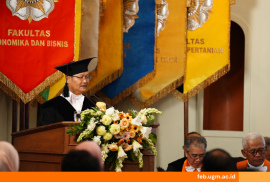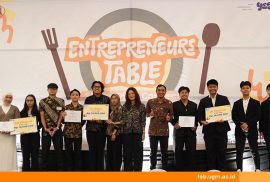
By Elan Satriawan & Wisnu Setiadi Nugroho
Department of Economics, Faculty of Economics and Business, Universitas Gadjah Mada (UGM)
The Program Makan Bergizi Gratis (MBG) stands as one of President Prabowo Subianto’s flagship policies under his Asta Cita vision for Indonesia Emas 2045. Launched on January 6, 2025, the program aims to provide free, nutritious meals to school-age children and vulnerable groups, addressing chronic malnutrition and stunting that constrain Indonesia’s human capital. Yet, the program’s early rollout reveals harsh lessons for welfare expansion in complex developing states. By September 2025, MBG had reached 22.7 million beneficiaries through 7,644 Satuan Pelayanan Pemenuhan Gizi (SPPG) units, with a target of nearly 32,000 SPPGs and 82.9 million recipients by year-end. However, only Rp 13 trillion, about 18.3 % of its Rp 71 trillion budget, had been disbursed by September 8. This low absorption underscores severe logistical, coordination, and administrative bottlenecks that challenge the program’s credibility.
The Delivery Dilemma
Although most SPPGs were initially established in easily accessible areas, where infrastructure and logistics should be most manageable, the program still suffers from serious quality-control failures. Many units face delayed fund transfers, procurement setbacks, and distribution inefficiencies that disrupt meal delivery. Mass food poisoning outbreaks have afflicted students: over 1,000 children fell ill in West Java alone in recent weeks, in one of many such incidents. Since the program was launched, over 6,400 children have been affected. Investigations by government agencies have confirmed that a lack of oversight and procedural lapses contributed to these outbreaks, including inconsistent cooking times, spoiled food, and inadequate kitchen certification. Laboratory tests detected contamination from E. coli, Salmonella, and Bacillus cereus, revealing systemic weaknesses in food handling, cold-chain management, and oversight mechanisms.
These incidents expose a fundamental issue: even under favorable conditions, quality assurance has not been enforced. Suppose such failures occur in “ready-to-go” regions. What will happen when the program expands to remote areas, where monitoring costs are higher, supply chains are weaker, and local oversight is limited? Without robust safeguards, scaling up too quickly could amplify risks rather than deliver benefits. A program designed to nourish should never endanger. The government’s immediate task is not to accelerate rollout but to pause, step back, and reevaluate, ensuring food safety and accountability before any expansion.
When Slow Disbursement Hurts Growth
Beyond operational problems, MBG’s underperformance has macroeconomic consequences. Government spending is a vital engine of domestic growth, and when disbursement stalls, fiscal stimulus weakens. As of September, only a fraction of MBG funds had reached local economies. Analysts and the finance ministry point to slow absorption across flagship programs, including MBG, as a factor that reduces liquidity and slows growth. The program’s poor execution effectively mutes its multiplier effects.
The Ministry of Finance acknowledged that slow spending across major programs, including MBG, has reduced liquidity and delayed fiscal transmission. In fact, in June 2025 the government had disbursed just Rp 4.4 trillion (≈ 2.6 % of the budget) toward MBG. That underperformance squeezed local economies that could have benefited from spending through food procurement, logistics, and wages. Meanwhile, growth projections for 2025 were revised downward to ~4.8%, with under-execution of public spending cited as among the headwinds.
The Cost of Ambition Without Precision
MBG’s fiscal weight is enormous roughly five to six times larger than allocations for Program Indonesia Pintar (PIP) and similar education subsidies. While this reflects the government’s strong commitment to nutrition and equality, it also demands prudence and precision in execution. Slow disbursement has already dampened public spending momentum, while inefficiencies risk crowding out other critical investments in classrooms, teachers, and infrastructure.
A universal approach also raises serious equity concerns. Equity arguments further demand scrutiny. According to the 2024 Susenas, fewer than 3 % of children report severe food insecurity—running out of food, feeling hungry without eating, or missing meals the whole day. Even among poorer households, the rate is about 6–7 %. Because this group is a minority, a universal free-meal design risks being both inefficient and regressive—benefiting children who do not require nutritional support.
A temporary consolidation phase is therefore not a retreat but a responsible course correction. Pausing expansion offers the opportunity to fix what matters most: food safety, accountability, and targeting accuracy. During this re-evaluation, the government could pilot a more focused delivery model, prioritizing students enrolled in Sekolah Rakyat or those listed in the Daftar Terpadu Sosial Ekonomi Nasional (DTSEN), children most likely to face nutritional risks. Leveraging DTSEN data would allow MBG to target households that genuinely require assistance, ensuring limited resources are directed where they can have the greatest impact.
Rethinking the Rollout
Design matters as much as capacity. Indonesia should also revisit the delivery model of MBG. The current centralized SPPG structure may not be optimal for a country as large and diverse as Indonesia. Globally, school feeding programs operate under two main approaches: centralized systems, where meals are prepared in large-scale facilities and distributed to schools, and decentralized systems, where local schools or communities manage cooking and distribution. Each model has its strengths. Centralization ensures uniformity and oversight, while decentralization promotes accountability, flexibility, and local relevance. For Indonesia, a hybrid model that combines standardized nutrition guidelines with community-based implementation may offer the best balance between efficiency and inclusiveness.
Indonesia can learn from its own social programs: PKH and BPNT, Both began as small-scale pilots, underwent rigorous evaluation, and were expanded nationally after demonstrating a measurable impact. MBG should adopt the same disciplined trajectory: evidence first, expansion later. The government can use this consolidation phase to test different delivery models — centralized, decentralized, and hybrid — across provinces to determine which approach delivers the best results in terms of safety, cost, and nutritional outcomes.
Moreover, implementation should be localized. Drawing from Japan’s community-based school lunch system, communities, schools, and parents can be more deeply involved in meal preparation, supervision, and adaptation. Local kitchens would reduce logistics costs, minimize spoilage, and heighten accountability. Finally, sourcing ingredients locally is key. Brazil’s PNAE mandates a minimum share (e.g. 30 %) of school-meal ingredients come from smallholder farms. Altogether, these reforms would transform MBG from a purely social program into a broader economic and community development initiative, one that not only feeds children but also revitalizes local agriculture, creates jobs, and strengthens social trust.
Regional Lessons and the Path Forward
MBG is one of Indonesia’s boldest social investments, an initiative that directly links nutrition, education, and productivity. Few programs so visibly embody the idea that human development and economic growth are inseparable. Yet the very ambition that defines MBG now risks undermining it. Food-safety lapses, poor targeting, and slow disbursement have weakened public confidence and dulled its developmental impact. To protect both citizens and credibility, the government must pause, step back, and recalibrate.
This period of reflection should not halt progress, but focus it. MBG can continue on a smaller, more strategic scale—prioritizing high-need districts while refining procurement systems, food-safety protocols, and delivery models. Feeding children well is not merely a welfare intervention; it is a moral and developmental imperative. The program’s promise will be realized only when every meal served is nutritious, safe, and targeted, and when its supply chains also empower local farmers and small businesses. That is how MBG can truly move from policy to plate, and from good intention to lasting impact.
Indonesia’s experience also carries lessons for Southeast Asia’s broader welfare expansion efforts. Across the region, governments are learning that ambition without precision can backfire—draining budgets, eroding trust, and diluting social returns. Rapid expansion without strong targeting, safety standards, and evaluation risks turns transformative programs into costly cautionary tales. Conversely, those that invest in pilots, local ownership, and evidence-based design can sustain both fiscal credibility and public confidence.
Feeding children well is therefore not just a national test; it is a measure of how effectively emerging Asian economies translate social spending into long-term human-capital gains. If implemented with discipline and evidence, MBG could become a regional model for inclusive growth—proof that social protection can be both equitable and efficient. If not, it may stand as a reminder that good intentions, without precision and governance, rarely lead to good outcomes.















